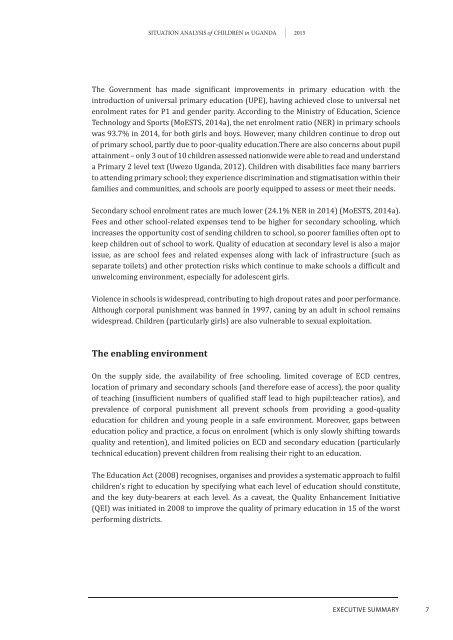Situation analySiS
1TNu802
1TNu802
Create successful ePaper yourself
Turn your PDF publications into a flip-book with our unique Google optimized e-Paper software.
<strong>Situation</strong> <strong>analySiS</strong> of Children in uganda 2015The Government has made significant improvements in primary education with theintroduction of universal primary education (UPE), having achieved close to universal netenrolment rates for P1 and gender parity. According to the Ministry of Education, ScienceTechnology and Sports (MoESTS, 2014a), the net enrolment ratio (NER) in primary schoolswas 93.7% in 2014, for both girls and boys. However, many children continue to drop outof primary school, partly due to poor-quality education.There are also concerns about pupilattainment – only 3 out of 10 children assessed nationwide were able to read and understanda Primary 2 level text (Uwezo Uganda, 2012). Children with disabilities face many barriersto attending primary school; they experience discrimination and stigmatisation within theirfamilies and communities, and schools are poorly equipped to assess or meet their needs.Secondary school enrolment rates are much lower (24.1% NER in 2014) (MoESTS, 2014a).Fees and other school-related expenses tend to be higher for secondary schooling, whichincreases the opportunity cost of sending children to school, so poorer families often opt tokeep children out of school to work. Quality of education at secondary level is also a majorissue, as are school fees and related expenses along with lack of infrastructure (such asseparate toilets) and other protection risks which continue to make schools a difficult andunwelcoming environment, especially for adolescent girls.Violence in schools is widespread, contributing to high dropout rates and poor performance.Although corporal punishment was banned in 1997, caning by an adult in school remainswidespread. Children (particularly girls) are also vulnerable to sexual exploitation.The enabling environmentOn the supply side, the availability of free schooling, limited coverage of ECD centres,location of primary and secondary schools (and therefore ease of access), the poor qualityof teaching (insufficient numbers of qualified staff lead to high pupil:teacher ratios), andprevalence of corporal punishment all prevent schools from providing a good-qualityeducation for children and young people in a safe environment. Moreover, gaps betweeneducation policy and practice, a focus on enrolment (which is only slowly shifting towardsquality and retention), and limited policies on ECD and secondary education (particularlytechnical education) prevent children from realising their right to an education.The Education Act (2008) recognises, organises and provides a systematic approach to fulfilchildren’s right to education by specifying what each level of education should constitute,and the key duty-bearers at each level. As a caveat, the Quality Enhancement Initiative(QEI) was initiated in 2008 to improve the quality of primary education in 15 of the worstperforming districts.ExECUtIvE SUMMary7




